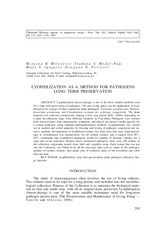Приказ основних података о документу
Lyophilization as a method for pathogens long term preservation
Liofilizacija kao metod dugoročnog čuvanja patogena
| dc.creator | Milošević, Mirjana | |
| dc.creator | Medić-Pap, Slađana | |
| dc.creator | Ignjatov, Maja | |
| dc.creator | Milošević, Dragana | |
| dc.date.accessioned | 2022-05-11T08:51:25Z | |
| dc.date.available | 2022-05-11T08:51:25Z | |
| dc.date.issued | 2007 | |
| dc.identifier.issn | 0352-4906 | |
| dc.identifier.issn | 2406-0828 | |
| dc.identifier.uri | http://fiver.ifvcns.rs/handle/123456789/2641 | |
| dc.description.abstract | Lyophilization (freeze-drying) is one of the most suitable methods used for a long term preservation of pathogens. The aim of this paper was the application of lyophilization for storage of three significant plant pathogens: Fusarium graminearum, Helminthosporium gramineum, and Pseudomonas syringae pv. gylicinea, respectively. The plant material was collected continuously (during a four year period 2002-2006), depending on a plant development stage, from different localities in Vojvodina. Pathogens were isolated from diseased parts with characteristic symptoms, and placed on nutritive media specific for a certain pathogen, using standard phytopathological methods. Lyophilization was carried out in marked and coded ampoules by freezing and drying of pathogen suspension and nutritive medium. Revitalization of lyophilized isolates was done after four days. High percentage of revitalization was characteristic for all studied isolates, and it ranged from 85-92%, confirming that lyophilized pathogens would be capable of keeping viability for a long time in the collection. Besides above-mentioned pathogens, there were 200 isolates in the collection, originating mostly from field and vegetable crops. Each isolate that was put into the Collection, was followed by all the necessary data such as: name of the pathogen, number of isolates, locality, host plant, year of isolation, name of the researcher and other relevant data. | sr |
| dc.description.abstract | Liofilizacija je jedna od najpogodnijih metoda koja se koristi za dugoročno čuvanje patogena. Cilj rada je primena metoda liofilizacije u čuvanju tri značajna biljna patogena: Fusarium graminearum, Helminthosporium gramineum i Pseudomonas syringae pv. gylicinea. Prikupljanje uzoraka biljnog materijala vršeno je u kontinuitetu (tokom četiri godine, 2002-2006) sa različitih lokaliteta na području Vojvodine, u zavisnosti od razvojne faze biljaka. Izolacija patogena vršena je iz obolelih biljnih delova sa karakterističnim simptomima na hranljive podloge specifične za određenog patogena korišćenjem standardnih fitopatoloških metoda. | sr |
| dc.language.iso | en | sr |
| dc.publisher | Novi Sad : Matica srpska | sr |
| dc.rights | openAccess | sr |
| dc.rights.uri | https://creativecommons.org/licenses/by-nc-nd/4.0/ | |
| dc.source | Zbornik Matice srpske za prirodne nauke | sr |
| dc.subject | lyophilization | sr |
| dc.subject | long time preservation | sr |
| dc.subject | plant pathogen | sr |
| dc.subject | collection | sr |
| dc.subject | fungi | sr |
| dc.subject | bacteria | sr |
| dc.subject | pathogens | sr |
| dc.subject | storage | sr |
| dc.subject | liofilizacija | sr |
| dc.subject | dugoročno čuvanje | sr |
| dc.subject | patogeni | sr |
| dc.subject | gljive | sr |
| dc.subject | bakterije | sr |
| dc.subject | čuvanje | sr |
| dc.subject | izolati | sr |
| dc.subject | isolates | sr |
| dc.title | Lyophilization as a method for pathogens long term preservation | sr |
| dc.title | Liofilizacija kao metod dugoročnog čuvanja patogena | sr |
| dc.type | article | sr |
| dc.rights.license | BY-NC-ND | sr |
| dc.citation.epage | 210 | |
| dc.citation.spage | 203 | |
| dc.citation.volume | 113 | |
| dc.identifier.fulltext | http://fiver.ifvcns.rs/bitstream/id/7175/0352-49060713203M.pdf | |
| dc.identifier.rcub | https://hdl.handle.net/21.15107/rcub_fiver_2641 | |
| dc.type.version | publishedVersion | sr |


